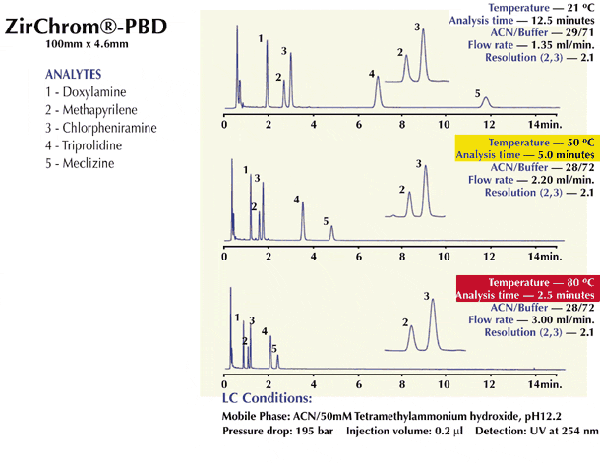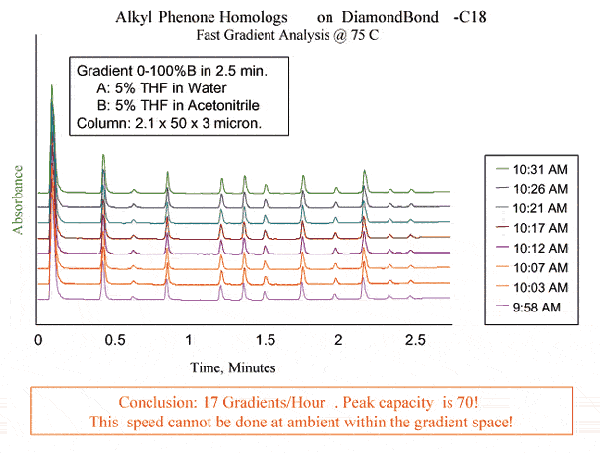
ELEVATED TEMPERATURE – HOW IT WORKS
Chromatographers have long known that modest increases in operating temperature can dramatically improve both the efficiency and speed of an HPLC separation. For example, in a recent article, David V. McCalley found large increases in the efficiency for basic compounds at elevated temperature 1. McCalley suggested both that basic compounds should be analyzed at higher temperatures and that new columns should be developed that are stable at high temperature.
There are three main effects that happen at elevated temperature. Firstly, the viscosity of the mobile phase is decreased, so that higher flow rates are possible with existing equipment without increasing backpressure. Secondly, at higher temperature, the diffusion of analytes into and back out of the pores of a chromatographic material is faster, so the efficiency of the separation generally improves. Finally, at elevated temperature, the kinetics of the interactions between the analytes and the stationary phase are faster. This will lower the overall retention, but also often reduces or eliminates tailed peaks.

HOW HOT IS HOT ENOUGH?
It is relatively simple to raise the operating temperature of an HPLC column. Most newer HPLC instruments include a column oven that is capable of thermostatting the column at up to 80 degree C.
For improved efficiency, an increase of even 10-20C often has a dramatic impact on peak shape, helping to baseline resolve an analyte that only gives a shouldered peak at room temperature. This is because the kinetics of secondary interactions, which often cause peak tailing, are accelerated at elevated temperature, eliminating the tail.
For improved speed, a typical analysis can be done in half the time by going from room temperature to 50 or 60C. Above 100C, it is not uncommon to decrease analysis time by a factor of 5. Also, re-equilibration time for the column is much shorter, so it is possible to do very fast gradient sweeps.
The decrease in retention with elevated temperature can be corrected by small adjustments to weaken the mobile phase (usually 5-20% less organic). The resolution of the separation is generally preserved or improved. So, a chromatographer can raise the temperature, weaken the mobile phase, and get a more efficient separation. Or, he can raise the temperature / weaken the mobile phase and then increase the flow rate, achieving a faster analysis with equal and sometimes better resolution.
HOW HOT IS TOO HOT?
There are three main concerns in running at elevated temperature: namely, the effects on temperature-sensitive analytes, HPLC equipment and columns.
Analytes
Some chromatographers (particularly in the pharmaceutical industry) are concerned about the effect of these techniques on temperature- sensitive compounds. Here, it is important to remember that the residence time of the analytes in the column is very short, so often, no degradation occurs. A recent
application note from Selerity Technologies shows that even a thermally unstable peroxide compound does not degrade at above 100C.
A survey of some 30 common drugs indicates no problem with most of the analytes. Even notoriously unstable beta-lactams can be run at 80C.
HPLC Equipment
Other chromatographers worry that their mobile phase will boil in the column, causing damage to their equipment and/or a safety hazard in the lab. It is important to remember, however, that the extremely high pressure in an HPLC column raises the boiling points of HPLC solvents, so that flashing cannot occur. Below 80C, it is not necessary to modify a standard HPLC system to operate safely. The tubing from the column to the detector and from the detector to the waste receptacle is sufficient to cool the mobile phase back to room temperature. Above 100C, adding a backpressure regulator after the detector to keep about 30 bar on the system is generally enough to prevent flashing. At very high temperatures (~150C), it is important to cool the mobile phase downstream of the column and before the detector.
Newer, high temperature column ovens generally incorporate this feature.
HPLC Columns
Elevated temperatures can be used with conventional HPLC columns, but can significantly reduce column life. At 60C, most silica-based materials degrade very quickly, unless operating conditions and buffers are chosen very carefully. To get good column life, a column based on a thermally stable support such as zirconia should be used.

If you have questions about this newsletter, you can e-mail them to us at: support@zirchrom.com.
Note that the following companies are also exploring high temperature
HPLC:
LEARN MORE
www.selerity.com
www.gtseptech.com (look at the HotSep page)